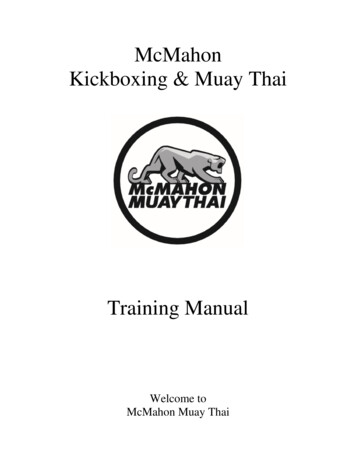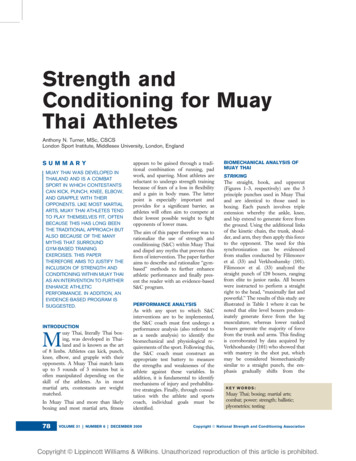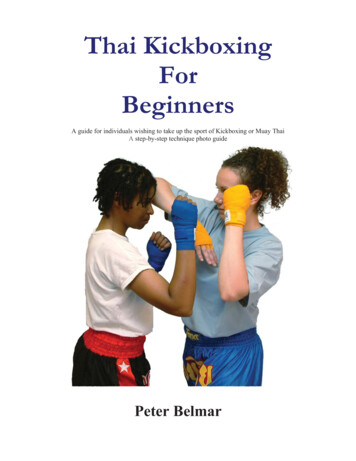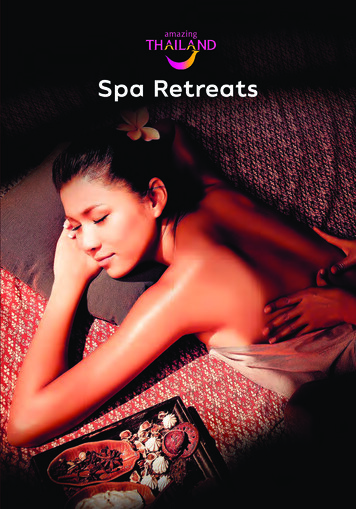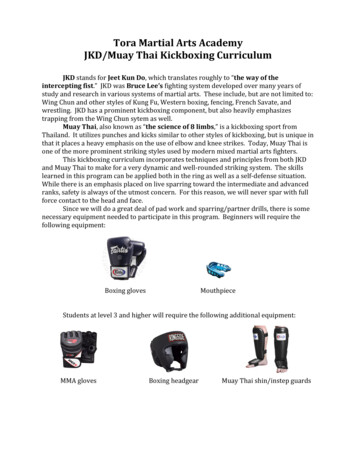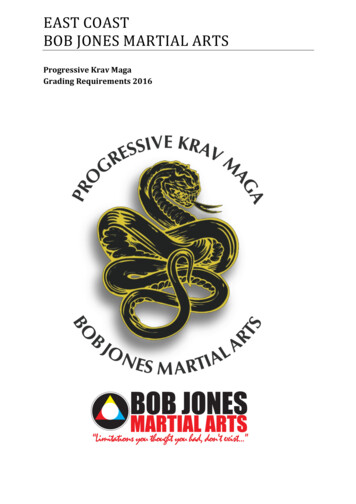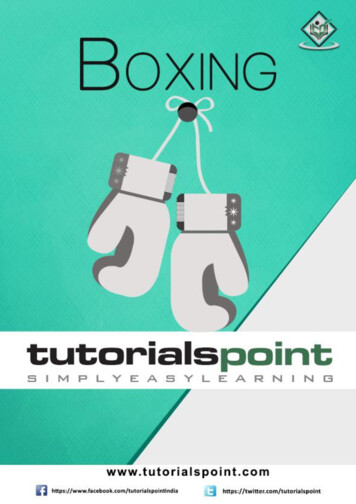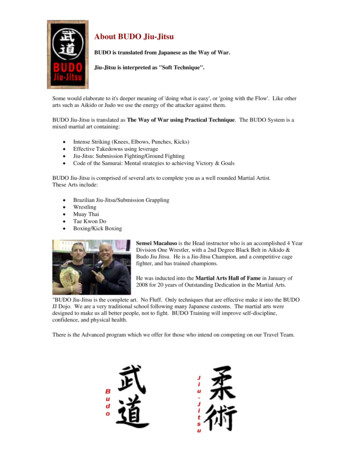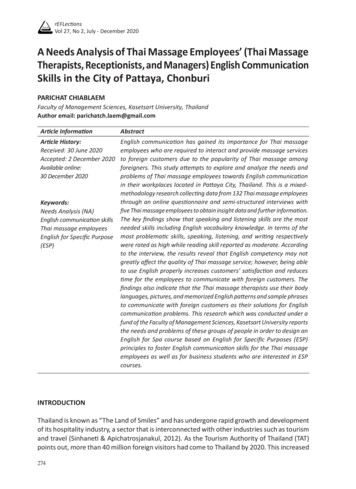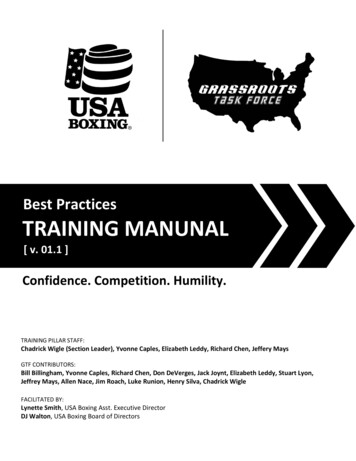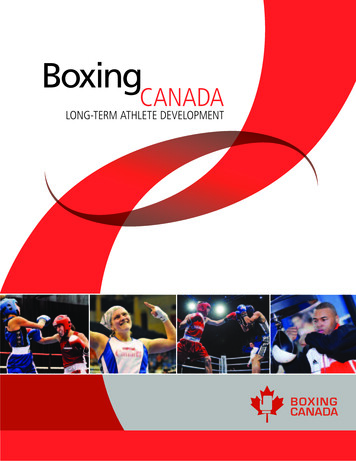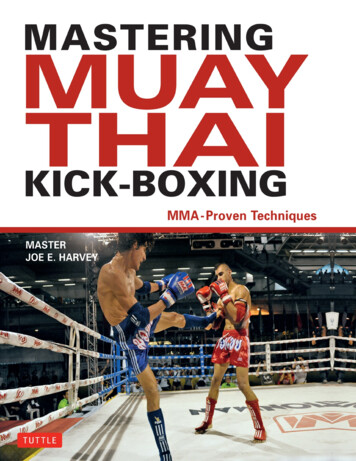
Transcription
CREDITSForeword by Patrick T. TraySubmissions Advisor Jeff JohnstonModels and Photo CreditsRick Tavares: Green/CamoAna Saldana: PinkMichael Custodio: BlueRichard S. Hemsley: Red/BlackJames W. Imel: Black (Fig. 160–166) Scott Harlan: Olive Green (Fig. 112, 113, 122, and 123)Combination and Endurance Drills Courtesy of Trident Academy of Martial ArtsDisclaimer: Please note that the publisher and author of this instructional book areNOT RESPONSIBLE in any manner whatsoever for any injury that may result frompracticing the techniques and/or following the instructions given within. Martial artstraining can be dangerous—both to you and to others—if not practiced safely. Ifyou're in doubt as to how to proceed or whether your practice is safe, consult with atrained martial arts teacher before beginning. Since the physical activities describedherein may be too strenuous in nature for some readers, it is also essential that aphysician be consulted prior to training.Published by Tuttle Publishing, an imprint of Periplus Editions (HK) Ltd., witheditorial offices at 364 Innovation Drive, North Clarendon, Vermont 05759 U.S.A.Copyright 2009 Joe E. HarveyAll rights reserved. No part of this publication may be reproduced or utilized in anyform or by any means, electronic or mechanical, including photocopying, recording,or by any information storage and retrieval system, without prior written permissionfrom the publisher.Harvey, Joe E.Mastering Muay Thai kick-boxing : MMA-proven techniques / Joe E. Harvey. -- 1sted.p. cm.ISBN 978-0-8048-4005-7 (pbk.); ISBN: 978-1-4629-0564-5 (ebook)1. Muay Thai. I. Title.GV1127.T45H37 2009796.815--dc222008053312
DISTRIBUTED BYNorth America,Latin America & EuropeTuttle Publishing364 Innovation DriveNorth ClarendonVT 05759-9436 U.S.A.Tel: 1 (802) 773-8930Fax: 1 (802) ing.comJapanTuttle PublishingYaekari Building, 3rd Floor5-4-12 OsakiShinagawa-kuTokyo 141 0032Tel: (81) 3 5437-0171Fax: (81) 3 5437-0755tuttle-sales@gol.comAsia Pacifi cBerkeley Books Pte. Ltd.61 Tai Seng Avenue #02-12Singapore 534167Tel: (65) 6280-1330Fax: (65) First edition12 11 10 096 5 4 3 2 1Printed in SingaporeTUTTLE PUBLISHING is a registered trademark of Tuttle Publishing, a division ofPeriplus Editions (HK) Ltd.Previous page: The straight knee #2 is a defense against an opponent's rightcross and includes a follow-up strike. Learn more about this technique onpage 86.Opposite: The left head pull is a defense against an opponent's right skipknee or right curve knee in the plum/clinch. Learn more about thistechnique on page 155.
DEDICATIONTo Richard Ernest HarveyA true warrior
lsDirectional AnglesLinear PositioningMUAY THAI STANCE*Lead Leg*Rear LegMOVEMENTForward Advance*StalkingBackwards RetreatLateral LeftLateral RightTurn Left (Quarter)Turn Right (Quarter)UPPER BODY STRIKESJabCrossHook (Left)Hook (Right)Low JabLow CrossLow HookUppercut (Left)Uppercut (Right)Horizontal Elbow (Left)Horizontal Elbow (Right)Down Elbow (Left)Down Elbow (Right)Up Elbow (Left)Up Elbow (Right)Spinning Back-Fist (Left)
Spinning Back-Fist (Right)Spinning Back-Elbow (Left)Spinning Back-Elbow (Right)Jump Fly Cross (Left)*Switch StepJump Fly Cross (Right)*Stutter StepJump Fly Elbow (Left)Jump Fly Elbow (Right)LOWER BODY STRIKESLeft Round KickRight Round KickCut Kick (Left)Cut Kick (Right)Left Angle KickRight Angle KickLong Foot JabShort Foot JabLong Knee (Left)Long Knee (Right)Jump Fly Knee (Left)Jump Fly Knee (Right)UPPER BODY DEFENSESParry (Left)Parry (Right)Cover High (Left)Cover High (Right)Cover Low Outside (Left)Cover Low Outside (Right)Cover Low Inside (Left)Cover Low Inside (Right)Cup/Catch (Left)Cup/Catch (Right)Slip (Left)Slip (Right)DuckBob and Weave (Left)Bob and Weave (Right)Shoulder Stop (Left)Shoulder Stop (Right)Straight Knee #1Straight Knee #2Elbow Jam (Left)Elbow Jam (Right)Push (Left)Push (Right)Retreat and AdvanceBackwards Retreat
LOWER BODY DEFENSESLead Leg ShieldCross ShieldSweep/Parry Left Round KickSweep/Parry Right Round KickParry Long Foot Jab InsideParry Long Foot Jab OutsideParry Short Foot Jab InsideParry Short Foot Jab OutsideParry Left Long Knee InsideParry Left Long Knee OutsideParry Right Long Knee InsideParry Right Long Knee OutsideLeft Angle Evade KickRight Angle Evade KickCatch Kick (Left)Catch Kick (Right)Retreat and AdvanceBackwards RetreatSTRIKE-DEFENSE TABLESUpper Body Strike-Defense TableLower Body Strike-Defense TablePLUM/CLINCH TIE-UPSDouble Head GrabHigh-Low (Left)High-Low (Right)Under ArmPLUM/CLINCH TIE-UP DEFENSESPummel (Left)Pummel (Right)Cross-face (Left)Cross-face (Right)Elbow Raise (Left)Elbow Raise (Right)Elbow Pull (Left)Elbow Pull (Right)Over/Under Snake (Left)Over/Under Snake (Right)PLUM/CLINCH STRIKESSkip Knees #1Skip Knees #2Curve Knee (Left)*Left Chip Knee
Curve Knee (Right)*Right Chip KneeSnap Elbow (Left)Snap Elbow (Right)PLUM/CLINCHPLUM/CLINCH DEFENSESHip Check (Left)Hip Check (Right)Hip Shift (Left)Hip Shift (Right)Pull Off Balance (Left)Pull Off Balance (Right)Head Pull (Left)Head Pull (Right)Leg Tie Outside (Left)Leg Tie Outside (Right)Leg Tie Inside (Left)Leg Tie Inside (Right)PLUM/CLINCH THROWSThrow (Left)Throw (Right)PERSONAL ATTACK RANGERANGE TABLEEQUIPMENTProtective EquipmentTraining EquipmentFOCUS MITTSUsing Focus MittsHolding Focus Mitts for Upper Body StrikesconfigreTHAI PADSUsing Thai PadsHolding Thai Pads for Upper Body StrikesHolding Thai Pads for Lower Body StrikesTRAINING DRILLS
ENDURANCE DRILLSCOMBINATION DRILLSSPECIFIC PROBLEM AREA TRAINING TIPSABOUT THE AUTHOR*Are included in description of another technique
FOREWORDMuay Thai is a ring fighting art and the national sport ofThailand. Its roots come from the combative and ancient art ofKrabi Krabong. Some refer to it as Thailand’s weapon art;however, it was more than just an art: it was the way the Thai’sfought wars. The techniques utilized in Krabi Krabong easilytransferred over to the techniques used early on in the sport ofMuay Thai, which has evolved over time to its current staturein the world of martial arts and international sports.Muay Thai is one of the fastest growing fight sports in theworld. Due to its popularity and effectiveness in the ring, it hasbecome one of the most prominent arts in the Mixed MartialArts (MMA) arena. Muay Thai’s effectiveness in the ring andMMA has become common knowledge to fans and fightersthroughout the world.What is not common knowledge is the effectiveness andwidespread use of Muay Thai in the military. I spent over 21years with the U.S. Navy SEAL Teams and throughout thattime, I witnessed numerous hand-to-hand combat programsthat were designed to market and teach military and lawenforcement. If it is a successful program, you can bet thatMuay Thai plays a large role in it. At my school, the TridentAcademy of Martial Arts, we teach numerous martial arts,including Muay Thai, in a program that combines the mostpractical techniques for self-defense from all the arts taught.Muay Thai is the most prominent art in that program for tworeasons: 1) the effectiveness of Muay Thai technique and 2) thetraining method of Muay Thai.Joe Harvey is a practitioner of numerous arts; however, at myacademy, he was a student of Muay Thai. When I refer to Joe asa student of Muay Thai, I am not referring to him as someonewho only trained in it, but as someone who studied the art
intensely. He meticulously took notes, became well-versed inthe art and thoroughly understood all the techniques andtraining methods. After viewing his notes, which are thefoundation of this book, I cannot recommend a betterrepresentation of Muay Thai than that found within thesepages. It is an outstanding aid to anybody training in MuayThai or MMA. Joe’s instructions are easy to follow, they breakdown the techniques in detail for both beginners and advancedstudents and put together intricate combinations. I highlyrecommend this book to all interested in Muay Thai or MMA.—Patrick TrayPatrick Tray is a four-time combat veteran who served 21 years as a member of theU.S. Navy SEAL Teams and served as the SEAL’s hand-to-hand combat instructor forover 10 years. Mr. Tray, owner and founder of Trident Academy of Martial Arts, is afull instructor and representative for the Thai Boxing Association of the U.S.A. (TBAUSA) and has full instructorship in Jun Fan Gung Fu/Jeet Kune Do Concepts andFilipino martial arts under Dan Inosanto. He is also a full instructor andrepresentative for other martial arts (e.g., Brazilian Jiu-Jitsu, combat submissionwrestling—CSW) under world-renowned instructors.
INTRODUCTIONMUAY THAIInterest in the art of Muay Thai is rapidly growing worldwidedue to its practical aspects as a method of self-defense, thephysical conditioning involved with Muay Thai training, thedevastating effectiveness as an element of Mixed Martial Arts(MMA) stand-up fighting, and the sport itself. Muay Thai,translated into English as Thai Boxing, is the national sport ofThailand and a martial art with origins in the warfare tactics ofthe Thai army. It evolved from Krabi Krabong (Krŭ –bē Krŭ –bŏng), the hand-to-hand tactics of the Thai army.Muay Thai is commonly referred to as the “Art of eightweapons” due to its utilization of eight striking weapons:hands, elbows, shins and knees. Muay Thai also features aunique form of standing grappling called the plum and/orclinch.The art of Muay Thai is always evolving. There may bedifferences in teaching styles and variations of techniques,depending on the lineage of instruction. One of the most vividexamples of its evolution is the change from the traditional armposition to its current form resembling Western-style boxing.This positive change affected striking and defensivetechniques.Learning Muay Thai, as with all martial arts, is based onbuilding a strong foundation of basic techniques and thenbuilding upon that foundation. As you progress in your training,you can add additional techniques and/or variations that youhave learned (e.g., hook kicks, which are not a standard MuayThai technique, are depicted being used in ancient drawings ofThai fighters).Muay Thai training methods develop speed, power, and
cardio-vascular endurance. Repetition is a very important partof training. Repetition develops “muscle memory,” whichconditions the body to perform techniques efficiently.THE BOOKThis book is structured as a learning manual and referencebook. It is the perfect companion for new students of MuayThai who can use the book to learn efficiently, whileexperienced students can use the book to refine theirtechniques.The information is presented in a straightforward way andthoroughly breaks down the mechanics of Muay Thai. Detailsgiven include weight distribution, striking area, line of attack,and other important information that allows one to perfect thetechniques and be effective. The book includes many learningaids such as photographs, stepping diagrams, tables, trainingdrills, training tips, and more.The entire book is based on the standard left lead position.Once you have a strong foundation in Muay Thai, you maychoose to train from a right lead position. All instruction isgiven from your perspective facing an opponent unlessspecifically stated (e.g., opponent’s right round kick, inside ofopponent’s left thigh). Once you understand the bodymechanics of a technique, practice it until it is smooth andfluid.Important points to keep in mind:The Muay Thai stance is the heart of the art and allmovement and techniques will originate and end with thisstance (unless you are engaged in the plum/clinch).Stay relaxed during all aspects of Muay Thai. Do not tenseup.Always keep your chin down and tucked.
Keep your head moving when in close range. Do not let itbe a sitting target.When performing a technique, focus on engaging the coremuscles of your abdominal area. Consistent training willcondition the core muscles and add power to yourtechniques.Focus the full extension of your strikes approximately 2-3inches behind the target for penetration.Do not “pose” after a technique. Always immediatelyfollow-up and/or quickly return to a defensive position.POWER SPEED X MASSNothing is set in stone. All techniques, including footwork,positioning, and defense, can be adjusted to the situationand/or opponent.
DIAGRAMSCENTERLINELEVELSDIRECTIONAL ANGLESLINEAR POSITIONING
MUAY THAI STANCELEAD LEGREAR LEG
This is the heart of Muay Thai.All techniques and movement will originate and end inthis stance (unless you are engaged in the plum/clinch).Keep chin down and tucked at all times, even duringtechniques and movement.The Muay Thai stance is a relaxed standing position. Stand upstraight, with torso squared off, and relax the shoulders.Put chin down.Fists are eye-level and a fist’s width apart.Fists are slightly turned out.Elbows are down and in toward the torso. (Fig. 5)
Fists are a fist’s width from face. (Fig. 6)Left leg is in front—LEAD LEGRight leg is behind—REAR LEGPlace feet shoulder-width apart.Point left lead leg and foot straight forward. Point right rear legand foot a little to the right at approximately a 45-degree anglewith heel up slightly.Align left lead leg heel and right rear leg toes. (Fig. 7)Knees will maintain a very slight bend.
Weight distribution should be even between both legs.
The entire book is based on the standard left lead leg position.Once you have a strong foundation in Muay Thai, you maychoose to train from a right lead leg position.
MOVEMENTFORWARD ADVANCEBACKWARDS RETREATLATERAL LEFTLATERAL RIGHTTURN LEFT (QUARTER)TURN RIGHT (QUARTER)
All movement should be smooth and in a relaxed state.With all movement, place feet down toe first, and then heelif needed.Always maintain a slight bend in the knees.FORWARD ADVANCEFrom Muay Thai stance, step forward with left lead leg andpush forward with right rear leg.Right rear leg will follow.End in Muay Thai stance.Stalking is using the forward advance in a relaxed state toclose the distance to opponent and keep constant pressure onopponent.BACKWARDS RETREATFrom Muay Thai stance, step backwards with right rear leg andpush backwards with left lead leg.Left lead leg will follow.End in Muay Thai stance.LATERAL LEFTFrom Muay Thai stance, step directly to the left with left leadleg and push to the left with right rear leg.Right rear leg will follow.
End in Muay Thai stance.LATERAL RIGHTFrom Muay Thai stance, step directly to the right with rightrear leg and push to the right with left lead leg.Left lead leg will follow.End in Muay Thai stance.TURN LEFT (QUARTER)From Muay Thai stance, step one full step forward with rightrear leg.Turn ¼ to the left by pivoting on both the left and right balls offeet.End in Muay Thai stance.TURN RIGHT (QUARTER)From Muay Thai stance, step back and to the left with rightrear leg.Turn ¼ to the right by pivoting on heel of left foot and ball ofright foot. (Fig. 9)End in Muay Thai stance.
UPPER BODYSTRIKESJABCROSSHOOK (LEFT)HOOK (RIGHT)LOW JABLOW CROSSLOW HOOK
UPPERCUT (LEFT)UPPERCUT (RIGHT)HORIZONTAL ELBOW (LEFT)HORIZONTAL ELBOW (RIGHT)DOWN ELBOW (LEFT)DOWN ELBOW (RIGHT)UP ELBOW (LEFT)UP ELBOW (RIGHT)SPINNING BACK-FIST (LEFT)SPINNING BACK-FIST (RIGHT)SPINNING BACK-ELBOW (LEFT)SPINNING BACK-ELBOW (RIGHT)
JUMP FLY CROSS (LEFT)JUMP FLY CROSS (RIGHT)JUMP FLY ELBOW (LEFT)JUMP FLY ELBOW (RIGHT)
JABThe jab is a quick snapping strike.Advance forward while striking.From Muay Thai stance, left fist punches eye-level in a straightline directly from hand position.Roll left shoulder forward into left side of face for coverage ofleft cheek and chin.Move right fist against right cheek for coverage of right cheekand chin. (Fig. 10)
Roll fist to strike with first two knuckles. At full extension, firsttwo knuckles will align with wrist, arm, and shoulder. (Fig. 11)The strike will move in a direct line to target.Return to Muay Thai stance.The jab also can be done from a stationary stance or anydirection of movement depending on distance and positioningwith target.CROSSThe cross is a power strike and should be fast and hard.
From Muay Thai stance, punch right fist at eye-level and in astraight line directly from hand position.Shift 95% of weight onto left lead leg and slightly bend knee ofleft lead leg.Pivot right rear leg inward and to the left, thrusting right hipand shoulder toward target by pivoting on ball of right foot.(Fig. 12)Roll right shoulder forward into right side of face for coverageof right cheek and chin.Move left fist against left cheek for coverage of left cheek andchin. (Fig. 13)
Roll fist to strike with first two knuckles. At full extension, firsttwo knuckles will align with wrist, arm, and shoulder.The strike will move in a direct line to target.Return to Muay Thai stance.The cross also can be done from any direction of movementdepending on distance and positioning with target.HOOK (LEFT)The left hook can be used as a fast and snapping strike orpower strike.From Muay Thai stance, raise left elbow eye-level creating ahorizontal line with fist.Fist position is vertical. (Fig. 14)
Shift 75% of weight to right rear leg. Right heel will go down“flatfooted.”Pivot left lead leg to the right by pivoting on ball of left foot andraising left heel. (Fig. 15)While pivoting, turn left hip and left side of torso towardsopponent to a left linear position. (Fig. 16)
The strike will move left to right with the force created frompivoting.Roll left shoulder forward into left side of face for coverage ofleft cheek and chin.Move right fist against right cheek for coverage of right cheekand chin.Strike with first two knuckles which should be aligned withwrist and forearm. (Fig. 14)Return to Muay Thai stance.
The left hook also can be done from any direction of movementdepending on distance and positioning with target.HOOK (RIGHT)The right hook can be used as a fast and snapping strike orpower strike.From Muay Thai stance, raise right elbow eye-level to create ahorizontal line with fist.Fist position is vertical. (Fig. 17)Shift 75% of weight to left lead leg.Pivot right rear leg inward and to the left on ball of right foot.(Fig. 18)
While pivoting, turn right hip and right side of torso towardopponent to a right linear position while maintaining a left leadstance.The strike will move right to left with the force created bypivoting.Roll right shoulder forward into right side of face for coverageof right cheek and chin.Move left fist against left cheek for coverage of left cheek andchin.Strike with first two knuckles which should be aligned withwrist and forearm. (Fig. 17)Return to Muay Thai stance.The right hook also can be done from any direction ofmovement depending on distance and positioning with target.LOW JABThe low jab is the same as the regular jab technique, but dropeye-level by bending both knees substantially while advancingand striking.
Do not lead with head. Keep back straight and only bendknees to lower level.Return to Muay Thai stance.LOW CROSSThe low cross is the same as the regular cross technique, butdrop eye-level by bending both knees substantially whilestriking.Do not lead with head. Keep back straight and only bendknees to lower level.Return to Muay Thai stance.LOW HOOK (LEFT AND RIGHT)The low hook is the same as the regular hook (left and right)technique, but drop eye-level by bending both kneessubstantially while striking.Do not lead with head. Keep back straight and only bendknees to lower level.Return to Muay Thai stance.UPPERCUT (LEFT)The left uppercut is a fast snapping strike.From Muay Thai stance, shift 95% of weight to left lead leg.Bend both knees approximately 6 inches.Roll right shoulder forward and dip left shoulder slightly.Strike with left fist on the centerline, low to high. (Fig. 19)
While striking, rotate left fist so palm is facing you. (Fig. 20)Push up with left lead leg and thrust left shoulder up andforward during the strike.Keep left outer forearm close to opponent and on centerlineduring the strike.Move right fist against right cheek for coverage of right cheekand chin.Strike with first two knuckles which should be aligned withwrist and forearm. (Fig. 21)
Return to Muay Thai stance.The left uppercut also can be done from any direction ofmovement depending on distance and positioning with target.UPPERCUT (RIGHT)The right uppercut is a fast snapping strike.From Muay Thai stance, shift 95% of weight to right rear leg.Bend both knees approximately 6 inches.Roll left shoulder forward and dip right shoulder slightly.Strike with right fist on the centerline, low to high. (Fig. 22)
While striking, rotate right fist so palm is facing you.Push up with right rear leg and thrust right shoulder up andforward during the strike.Keep right outer forearm close to opponent and on centerlineduring the strike.Move left fist against left cheek for coverage of left cheek andchin.Strike with first two knuckles which should be aligned withwrist and forearm. (Fig. 23)
Return to Muay Thai stance.The right uppercut also can be done from any direction ofmovement depending on distance and positioning with target.HORIZONTAL ELBOW (LEFT)The left horizontal elbow is a fast snapping strike.From Muay Thai stance, raise both elbows so fists areforehead-level.Move right arm slightly to the left and rotate forearm out (palmaway) for coverage.Lift left elbow up to align horizontal with left fist and rotateforearm out (palm away). (Fig. 24)
Strike by snapping point of left elbow forward to centerline. Donot over extend past centerline.Relax left hand so it can bend at wrist against center of chest.(Fig. 25)Thrust left shoulder forward slightly and shift 75% of weight toright rear leg while striking.Pivot left lead leg inward and to the right on ball of left footand raise left heel during the strike. (Fig. 26)
The strike will move left to right in a horizontal line.The strike can be used to rip and tear with the point of theelbow or hit with the bottom three inches of the outer forearmnear the elbow. (Fig. 27)Return to Muay Thai stance.The left horizontal elbow also can be done from any direction ofmovement depending on distance and positioning with target.HORIZONTAL ELBOW (RIGHT)
The right horizontal elbow is a fast snapping strike.From Muay Thai stance, raise both elbows so fists areforehead-level.Move left arm slightly to the right and rotate forearm out (palmaway) for coverage.Lift right elbow up to align horizontal with right fist and rotateforearm out (palm away). (Fig. 28)Strike by snapping point of right elbow forward to centerline.Do not over extend past centerline.Relax right hand so it can bend at wrist against center of chest.(Fig. 29)
Thrust right shoulder forward slightly and shift 75% of weightto left lead leg while striking.Pivot right rear leg inward and to the left on ball of right footand raise right heel during the strike. (Fig. 30)The strike will move right to left in a horizontal line.The strike can be used to rip and tear with the point of theelbow or hit with the bot-tom three inches of the outer forearmnear the elbow. (Fig. 31)
Return to Muay Thai stance.The right horizontal elbow also can be done from any directionof movement depending on distance and positioning withtarget.DOWN ELBOW (LEFT)The left down elbow is a fast snapping strike.From Muay Thai stance, raise both elbows so fists areforehead-level.Move right arm slightly to the left and rotate forearm out (palmaway) for coverage.Lift left elbow straight up dropping left fist to align elbow andfist as vertical as possible and rotate forearm out (palm away).(Fig.32)
Strike by snapping point of left elbow downward on centerline.Relax left hand so it can bend at wrist against center of chest.(Fig.33)Thrust left shoulder forward slightly and shift 75% of weight to
right rear leg while striking.Pivot left lead leg inward and to the right on ball of left footand raise left heel during the strike. (Fig. 34)The strike will move high to low on centerline.The strike can be used to rip and tear with the point of theelbow or hit with the bottom three inches of the outer forearmnear the elbow. (Fig. 35)Return to Muay Thai stance.The left down elbow also can be done from any direction ofmovement depending on distance and positioning with target.
DOWN ELBOW (RIGHT)The right down elbow is a fast snapping strike.From Muay Thai stance, raise both elbows so fists areforehead-level.Move left arm slightly to the right and rotate forearm out (palmaway) for coverage.Lift right elbow straight up dropping right fist to align elbowand fist as vertical as possible and rotate forearm out (palmaway). (Fig. 36)Strike by snapping point of right elbow downward oncenterline.Relax right hand so it can bend at wrist against center of chest.(Fig. 37)
Thrust right shoulder forward slightly and shift 75% of weightto left lead leg while striking.Pivot right rear leg inward and to the left on ball of right footand raise right heel during the strike. (Fig. 38)The strike will move high to low on center-line.The strike can be used to rip and tear with the point of theelbow or hit with the bot-tom three inches of the outer forearmnear the elbow. (Fig. 39)
Return to Muay Thai stance.The right down elbow also can be done from any direction ofmovement depending on distance and positioning with target.UP ELBOW (LEFT)The left up elbow is a fast snapping strike.From Muay Thai stance, raise right elbow so right fist isforehead-level.Move right arm slightly to the left and rotate forearm out (palmaway) for coverage.Left elbow will strike from original position.Strike by snapping point of left elbow upward on centerline.Relax left hand so it can bend at wrist against center of chest.Thrust left shoulder forward substantially to raise elbow to eyelevel and twist upper body to an almost left linear position.(Fig. 40)
Shift 75% of weight to right rear leg while striking.Pivot left lead leg inward and to the right on ball of left footand raise left heel during the strike. (Fig. 41)
The strike will move low to high on centerline.The strike can be used to rip and tear with the point of theelbow or hit with the bottom three inches of the outer forearmnear the elbow. (Fig. 42)Return to Muay Thai stance.The left up elbow also can be done from any direction ofmovement depending on distance and positioning with target.UP ELBOW (RIGHT)
The right up elbow is a fast snapping strike.From Muay Thai stance, raise left elbow so left fist is foreheadlevel.Move left arm slightly to the right and rotate forearm out (palmaway) for coverage.Right elbow will strike from original position.Strike by snapping point of right elbow upward on centerline.Relax right hand so it can bend at wrist against center of chest.Thrust right shoulder forward substantially to raise elbow toeye-level and twist upper body to an almost right linearposition. (Fig. 43)
Shift 75% of weight to left lead leg while striking.Pivot right rear leg inward and to the left on ball of right footand raise right heel during the strike. (Fig. 44)
The strike will move low to high on centerline.The strike can be used to rip and tear with the point of theelbow or hit with the bottom three inches of the outer forearmnear the elbow. (Fig. 45)Return to Muay Thai stance.The right up elbow also can be done from any direction ofmovement depending on distance and positioning with target.SPINNING BACK-FIST (LEFT)The left spinning back-fist is a fast power strike usingcentrifugal force.
From Muay Thai stance, take a full step forward and to the leftacross the body and past centerline with right rear leg.Drop 100% of weight to right leg.Lift left foot slightly off ground and spin counter-clockwise bypivoting on ball of right foot.Left leg will land in original left lead leg position facingopponent. (Fig. 46)Turn head to the left to keep visual contact with opponentduring the spin.Strike with left fist while spinning.Straighten left arm during spin. Leave a slight bend inelbow.Slightly bend left wrist to position first two knuckles ahead ofarm. (Fig. 47)
Power is created by the speed and centrifugal force of the spin.Move right fist against right cheek for coverage of right cheekand chin.The strike will move right to left in a horizontal line.Strike with first two knuckles from backside of fist.Return to Muay Thai stance facing opponent.SPINNING BACK-FIST (RIGHT)The right spinning back-fist is a fast power strike usingcentrifugal force.
From Muay Thai stance, take a full step forward and to theright across the body and past centerline with left lead leg.Drop 100% of weight to left leg.Lift right foot slightly off ground and spin clockwise by pivotingon ball of left foot.Right leg will spin completely around and land in original rightrear leg position. (Fig. 48)Turn head to the right to keep visual contact with opponentduring the spin.Strike with right fist while spinning.Straighten right arm during spin. Leave a slight bend in elbow.Slightly bend right wrist to position first two knuckles ahead ofarm. (Fig. 49)
Power is created by the speed and centrifugal force of the spin.Move left fist against left cheek for coverage of left cheek andchin.The strike will move left to right in a horizontal line.Strike with first two knuckles from backside of fist.Return to Muay Thai stance facing opponent.SPINNING BACK-ELBOW (LEFT)The left spinning back-elbow is a fast power strike usingcentrifugal force.From Muay Thai stance, take a full step forward and to the leftacross the body and past centerline with right rear leg.Drop 100% of weight to right leg.
Lift left foot slightly off ground and spin counter-clockwise bypivoting on ball of right foot.Left leg will land in original left lead leg position
pages. It is an outstanding aid to anybody training in Muay Thai or MMA. Joe’s instructions are easy to follow, they break down the techniques in detail for both beginners and advanced students and put together intricate combinations. I highly recommend this
